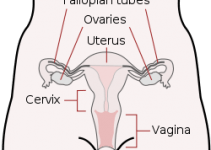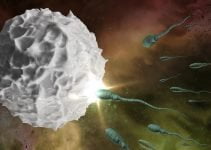Seven days past ovulation (7 DPO) is a key point in your menstrual cycle. Your body is preparing for a possible pregnancy during this time.
Implantation of a fertilized egg may be starting now. Hormone levels, especially progesterone, are rising to support this process.
You might notice mild cramping, breast tenderness, or fatigue. It’s also normal to feel nothing at all at this stage.
Testing for pregnancy now is usually too early. Hormone levels may not be high enough for a test to detect pregnancy, but some sensitive tests might show a faint sign.
What Happens at 7 Days Past Ovulation
At 7 days past ovulation, your body is going through several important changes. The egg you released is still on its journey, and fertilization may have already happened.
Your hormones are changing to support these steps. These changes help prepare your uterus for a possible pregnancy.
Ovulation and Egg Journey
Ovulation is when your ovary releases a mature egg. This usually happens around the middle of your menstrual cycle. You may feel ovulation symptoms.
After ovulation, the egg moves into the fallopian tube. Your egg can survive for about 12 to 24 hours after ovulation.
If you had intercourse during this time, sperm may meet the egg in the fallopian tube. If fertilization does not occur, the egg will break down and leave your body with your next period.
Fertilization and the Zygote
If sperm meets your egg, they join to form a single cell called a zygote. This is the start of a possible pregnancy.
The zygote divides and travels down the fallopian tube toward your uterus. At 7 days past ovulation, the embryo is still on this journey.
Fertilization usually happens within 24 hours after ovulation. The journey to the uterus takes several days.
Implantation Timeline
Implantation is when the embryo attaches to the lining of your uterus. This usually happens between 6 and 12 days after ovulation.
At 7 days past ovulation, the embryo may be starting to implant or is getting close. Your uterine lining has been thickening to support this process.
Once implantation occurs, your body starts producing the hormone hCG. Signs of implantation can include mild cramping or light spotting, but many women don’t notice any symptoms at this stage.
Common 7 DPO Symptoms
At 7 days past ovulation, hormonal changes can cause symptoms that may feel similar to PMS or early pregnancy. You might notice changes in your energy, mood, or how your body feels.
Fatigue and Tiredness
You may feel more tired than usual around 7 DPO. Progesterone levels rise after ovulation and can make you feel sleepy or low on energy.
Fatigue is common, whether or not you are pregnant. Your body is working hard to support possible implantation.
Mood Swings and Emotional Changes
Mood swings can happen because of shifting hormone levels. You might feel more emotional, irritable, or sensitive than usual.
These feelings are normal and can be mistaken for PMS. Be gentle with yourself and recognize that mood changes are part of your cycle.
Bloating and Digestive Discomfort
Bloating is common at this stage. Progesterone slows digestion, which can cause gas and a feeling of fullness.
You may also have mild cramping or changes in your bowel movements. These signs are similar to PMS but can also be early pregnancy symptoms.
Physical Signs to Watch For
Your body experiences several physical changes at 7 days past ovulation. Hormones like progesterone increase and can affect how you feel.
Tender Breasts and Nipple Sensitivity
You might notice your breasts feeling tender or sore. Progesterone causes breast tissue to retain fluid and swell.
Your nipples may also feel more sensitive or tingly. Veins on your breasts might look more visible.
If you are not pregnant, this tenderness usually goes away after your period starts. If you are pregnant, the sensitivity may continue and become stronger.
Headaches and Back Pain
Some women experience headaches or back pain around this time. Rising progesterone can trigger headaches that may feel dull or throbbing.
Back pain may feel like a mild ache or pressure in your lower back or pelvic area. These symptoms are usually mild but can be uncomfortable.
Staying hydrated, resting, and managing stress can help reduce these symptoms.
Cramps and Pelvic Pressure
You might feel cramping or pressure in your pelvis as your uterus prepares for possible implantation. Implantation cramps are usually light and short-lived.
Pelvic pressure can come from the uterus expanding slightly or from increased blood flow. You may feel a sense of fullness or heaviness.
If cramps are severe or you have heavy bleeding, contact your healthcare provider. Mild cramping at 7 DPO is usually normal.
Understanding Pregnancy Symptoms Versus PMS
It can be difficult to tell the difference between early pregnancy symptoms and PMS. Many signs overlap, making it confusing.
Differences in Symptom Timing
Pregnancy symptoms often start after implantation, which can happen 6 to 12 days after ovulation. At 7 DPO, some early signs may begin, but most symptoms still resemble PMS.
PMS symptoms usually show up a few days before your period and peak right before it starts. If your symptoms last beyond your usual period start date, it could be an early sign of pregnancy.
Overlapping Signs
Both early pregnancy and PMS can cause breast tenderness, cramping, mood swings, fatigue, and bloating. Hormonal changes are responsible for these symptoms.
You might also notice increased urination, nausea, or changes in cervical mucus if you are pregnant, but these are less common with PMS. Tracking your symptoms and their timing can help you understand what is happening in your body.
The Role of Hormones at 7 DPO
Your body goes through specific hormonal changes around 7 days past ovulation. Progesterone and human chorionic gonadotropin (hCG) play important roles at this stage.
Progesterone Increase After Ovulation
After ovulation, your body raises progesterone levels. The corpus luteum, which forms where the egg was released, produces this hormone.
Progesterone thickens your uterine lining to prepare for a fertilized egg. You may notice symptoms like breast tenderness, fatigue, or mild cramping as a result.
Progesterone also slows digestion, which can make you feel bloated. It can cause you to need to urinate more often.
Rise of Human Chorionic Gonadotropin (hCG)
hCG is a hormone produced only if implantation occurs. Around 7 DPO, the fertilized egg may begin to implant, but hCG levels are usually still very low.
After implantation, the embryo starts releasing hCG. This hormone signals your body to maintain the uterine lining and support pregnancy.
hCG usually isn’t high enough to be detected by home pregnancy tests at 7 DPO. Most tests become accurate closer to 10 to 14 DPO.
Taking a Pregnancy Test After 7 DPO
At 7 days past ovulation, your body may be starting to show signs of pregnancy, but it is still very early for testing. Knowing when to test helps you get accurate results.
When to Test for Accurate Results
Most home pregnancy tests detect hCG, which rises after implantation. Since implantation usually happens between 6 to 12 days after ovulation, hCG may still be too low to detect at 7 DPO.
Testing at 7 DPO often gives a negative or unclear result. For better accuracy, wait until at least 10 to 14 days past ovulation.
If you have a short menstrual cycle, you might consider testing a bit earlier with a sensitive test. However, testing too soon can lead to false negatives. More details on when to take a pregnancy test here.
Interpreting Early Test Outcomes
A negative result at 7 DPO does not always mean you are not pregnant. hCG levels may not be high enough yet, so wait a few days and test again if your period is late.
A positive result at 7 DPO is rare but possible with very sensitive tests. If you see a positive, contact your healthcare provider for confirmation and guidance.
Early symptoms like mild cramping, breast tenderness, or spotting can happen now but may also be premenstrual signs. Use your test results along with symptom tracking for the best understanding.
Frequently Asked Questions
At 7 days past ovulation, your body may show subtle changes. It can be hard to tell if these mean pregnancy.
What symptoms might I experience at 7 DPO, and are they indicative of pregnancy?
You may feel cramping, breast tenderness, fatigue, or nausea. These symptoms can happen with pregnancy but also with normal hormonal changes.
Not having symptoms at 7 DPO does not mean you are not pregnant. Every woman’s experience is different.
Is it possible to take a pregnancy test 7 days after ovulation, and how accurate would it be?
You can test at 7 DPO, but most tests will be negative. Pregnancy hormone levels (hCG) are often not high enough yet to detect.
Some sensitive tests might show a faint positive, but these results are not very reliable at this stage.
How does implantation timing correlate with 7 DPO, and what signs should I be aware of?
Implantation usually happens between 6 and 12 days after ovulation. At 7 DPO, implantation could just be starting.
Signs may include light cramping or spotting, but many women do not notice any symptoms during implantation.
Can progesterone levels at 7 DPO provide early pregnancy clues, and should they be tested?
Progesterone rises after ovulation to prepare your uterus. Higher levels at 7 DPO support pregnancy but do not confirm it.
Testing progesterone alone is not a reliable way to detect pregnancy at this point.
What are the chances of a false negative on a pregnancy test taken at 7 DPO?
If you take a pregnancy test at 7 days past ovulation (7 DPO), there is a high chance of getting a false negative result. This is because the hormone hCG may still be too low for the test to detect.
A negative test at this stage does not always mean you are not pregnant. It is best to wait a few more days and test again for a more accurate result.
How can I differentiate between premenstrual symptoms and early pregnancy signs at 7 DPO?
Symptoms such as bloating, breast tenderness, and mood swings can occur with both premenstrual syndrome (PMS) and early pregnancy.
At 7 days past ovulation (7 DPO), it is hard to tell the difference between PMS and early pregnancy based on symptoms alone, but we wrote a detailed comparison here. If you suspect you might be pregnant, it is best to wait until your period is due and take a pregnancy test for more accurate results. Here’s what you need to know about home pregnancy tests.


